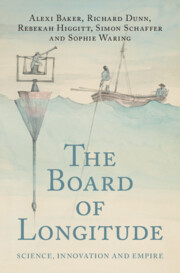Book contents
- The Board of Longitude
- The Board of Longitude
- Copyright page
- Dedication
- Contents
- Figures
- Tables
- Boxes
- Acknowledgements
- Timeline
- Abbreviations
- 1 Introduction
- 2 Sailing the Oceans and Seeking Longitude before 1714
- 3 Launching the Eighteenth-Century Search for Longitude
- 4 The Early Commissioners in Transition
- 5 The Birth of the Board of Longitude
- 6 Time Trials
- 7 Manufacturing the Nautical Almanac
- 8 Managing, Communicating and Judging Longitude after Harrison, 1774–c. 1800
- 9 A Practical Institution Weighed Down by Impractical Proposals?
- 10 What Is an Observatory? From the Metropolis to the Cape
- 11 The Death and Rebirth of the Board of Longitude
- Epilogue
- Book part
- Glossary
- Bibliography
- Index
7 - Manufacturing the Nautical Almanac
Published online by Cambridge University Press: 11 April 2025
- The Board of Longitude
- The Board of Longitude
- Copyright page
- Dedication
- Contents
- Figures
- Tables
- Boxes
- Acknowledgements
- Timeline
- Abbreviations
- 1 Introduction
- 2 Sailing the Oceans and Seeking Longitude before 1714
- 3 Launching the Eighteenth-Century Search for Longitude
- 4 The Early Commissioners in Transition
- 5 The Birth of the Board of Longitude
- 6 Time Trials
- 7 Manufacturing the Nautical Almanac
- 8 Managing, Communicating and Judging Longitude after Harrison, 1774–c. 1800
- 9 A Practical Institution Weighed Down by Impractical Proposals?
- 10 What Is an Observatory? From the Metropolis to the Cape
- 11 The Death and Rebirth of the Board of Longitude
- Epilogue
- Book part
- Glossary
- Bibliography
- Index
Summary
This chapter details the creation and management of the Nautical Almanac, one of the Board of Longitude’s most important concerns. Appointed Astronomer Royal and thus a Commissioner of Longitude in 1765, Nevil Maskelyne oversaw its publication and that of associated texts, directing the work of a group of mathematical computers overseen by comparers. Hierarchical organisation and increasing costs preoccupied much of the Board of Longitude’s subsequent affairs. Calculated up to a decade in advance, the Nautical Almanac became a symbol of the Board’s repute among foreign academies and observatories, although its accuracy was later subject to satire and criticism. After Maskelyne’s death, work seems to have suffered and its management was overhauled by the Longitude Act of 1818 that brought it under Thomas Young’s management. Controversy wracked the Board’s direction of the Nautical Almanac for the next decade. Its assignment from 1831 to the astronomer William Stratford as superintendent was a major element of the aftermath of the Board’s abolition.
Keywords
- Type
- Chapter
- Information
- The Board of LongitudeScience, Innovation and Empire, pp. 157 - 191Publisher: Cambridge University PressPrint publication year: 2025

